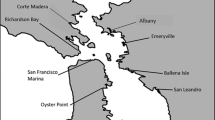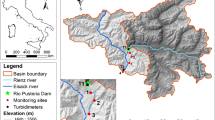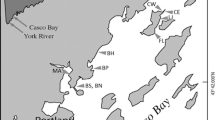Abstract
Monitoring of small-scale distribution patterns of benthic invertebrates has demonstrated distinct trends in faunal abundances with position relative to individual culms of saltmarsh cordgrass,Spartina alterniflora, at Tar Landing Bay Marsh, near Morehead City, North Carolina. Samples containing culms ofSpartina yielded significantly higher abundances (at least three times) than did samples without them. Among common species, onlyNereis succinea did not show this effect. Matrix-arranged and randomly placed sets of samples have confirmed a positive relationship between cross-sectional area of culms in a sample (at the sediment-water interface) and contained numbers of macrofauna, juvenile macrofauna and meiofauna. These patterns occurred despite a decreased volume of sediment in samples containing culms. Heightened abundances of benthic invertebrates associated with structural elements at the sediment-water interface may result from either nonrandom recruitment (either active via recruit selectivity or passive through hydrogeographic effects of culms) or differential post-recruitment mortality (resulting from inhibition of epibenthic predators or from variable habitat quality).
Similar content being viewed by others
Literature Cited
Bailey-Brock, J. H. 1979. Sediment trapping by chaetopterid polychaetes on a Hawaiian fringing reef.J. Mar. Res. 37:643–656.
Bell, S. S. 1980. Meiofauna-macrofauna interactions in a high salt marsh habitat.Ecol. Monogr 50:487–505.
Bell, S. S., andB. C. Coull. 1978. Field evidence that shrimp predation regulates meiofauna.Oecologia 35:141–148.
Bell, S. S., andB. C. Coull. 1978. Experimental evidence for a model of juvenile macrofauna-meiofauna interactions, p. 179–192.In K. R. Tenore and B. C. Coull (eds.), Marine Benthic Dynamics. University of South Carolina Press, Columbia.
Bell, S. S., M. C. Watzin, andB. C. Coull. 1978. Biogenic structure and its effects on the spatial heterogeneity of meiofauna in a salt marsh.J. Exp. Mar. Biol. Ecol. 35:99–107.
Boesch, D. F. 1977. A new look at the zonation of benthos along the estuarine gradient, p. 245–266.In B. C. Coull (ed.), Ecology of Marine Benthos. University of South Carolina Press, Columbia.
Brook, I. M. 1978. Comparative macrofauna abundance in turtlegrass (Thalassia testudinum) communities in south Florida characterized by high blade density.Bull. Mar. Sci. 28:212–217.
Carlson, P. R. 1980. Oxygen diffusion from the roots ofSpartina alterniflora and the role ofSpartina in the sulfur cycle of salt marsh sediments. Ph.D. Dissertation, University of North Carolina, Chapel Hill. 188 p.
De Jonge, A. M., andL. A. Bouwman. 1977. A simple density separation technique for quantiative isolation of meiobenthos using the colloidal silica Ludox-TM.Mar. Biol. 42:143–148.
Eckman, J. E. 1979. Small-scale patterns and processes in a soft-substratum intertidal community.J. Mar. Res. 37:437–457.
Fager, E. W. 1964. Marine sediments: effects of a tube-building polychaete.Science 143:356–359.
Fleeger, J. W., S. A. Whipple, andL. L. Cook. 1982. Field manipulations of tidal flushing, light exposure and natant macrofauna in a Louisiana salt marsh: effects on the meiofauna.J. Exp. Mar. Biol. Ecol. 56:87–100.
Hannan, C. A. 1981. Polychaete larval settlement: correspondence of patterns in suspended jar collectors and in the adjacent natural habitat in Monterey Bay, California.Limnol. Oceanogr. 26:159–171.
Heck, K. L., andG. S. Wetstone. 1977. Habitat complexity and invertebrate species richness and abundance in tropical seagrass meadows.J. Biogeogr. 4:135–143.
Highsmith, R. C. 1982. Induced settlement and metamorphosis of sand dollar (Dendraster excentricus) larvae in predator-free sites: adult sand dollar beds.Ecology 63:329–327.
Hogue, E. W., andC. B. Miller. 1981. Effects of sediment microtopography on small-scale spatial distributions of meiobenthic nematodes.J. Exp. Mar. Biol. Ecol. 53:181–191.
Howes, B. L., R. W. Howarth, J. M. Teal, andI. Valiela. 1981. Oxidation-reduction potentials in a salt marsh: spatial patterns and interactions with primary production.Limnol. Oceanogr. 26:350–360.
Kirchman, D., S. Graham, D. Reish, andR. Mitchell. 1982. Bacteria induce settlment and metamorphosis ofJanua (Dexiospira) brasiliensis Grube (Polychaeta: Spirorbidae).J. Exp. Mar. Biol. Ecol. 56:153–163.
Kneib, R. T. 1984. Patterns of invertebrate distribution and abundance in the intertidal salt marsh: causes and questions.Estuaries (in press).
Kneib, R. T., andA. E. Stiven. 1982. Benthic invertebrate responses to size and density manipulations of the common mummichog,Fundulus heteroclitus (L.) in an intertidal salt marsh.Ecology 63: 1518–1532.
Levin, L. A. 1981. Dispersion, feeding behavior and competition in two spionoid polychaetes.J. Mar. Res. 39:99–177.
McCall, P. L., andJ. B. Fisher. 1980. Effects of tubificid oligochaetes on physical and chemical properties of Lake Erie sediments, p. 253–317.In R. O. Brinkhurst (ed.), Aquatic Oligochaete Biology. Plenum Press, New York.
McIntyre, A. D. 1964. Meiobenthos of sublittoral muds.J. Mar. Biol. Assoc. U.K. 44:665–674.
Mills, E. L. 1967. The biology of an ampeliscid crustacean sibling species pair.J. Res. Board Can. 24: 305–355.
Oliver, J. S. 1979. Physical and biological processes affecting the organization of marine soft-bottom communities in Monterey Bay, California and McMurdo Sound, Antarctica. Ph.D. Dissertation, Scripps Institute of Oceanography.
Orth, R. J. 1977. The importance of sediment stability in seagrass communities, p. 281–300.In B. C. Coull (ed.), Ecology of Marine Benthos. University of South Carolina Press, Columbia.
Osenga, G. A., andB. C. Coull. 1983.Spartina alterniflora Loisel root structure and meiofaunal abundance.J. Exp. Mar. Biol. Ecol. 67:221–225.
Peterson, C. H. 1979. Predation, competitive exclusion, and diversity in the soft-sediment benthic communities of estuaries and lagoons, p. 233–264.In R. J. Livingston (ed.), Ecological Processes in Coastal marine Systems. Plenum Press, New York.
Peterson, C. H. 1980. Approaches to the study of competition in benthic communities in soft sediments, p. 291–302.In V. S. Kennedy (ed.), Estuarine Perspectives. Academic Press, New York.
Pomeroy, W. M., andC. D. Levings. 1980. Associations and feeding relationships betweenEogammarus confervicolous (Amphipoda, Gammaridea) and benthic algae on Sturgeon and Roberts Banks, Frasier River Estuary.Can. J. Fish. Aquat. Sci. 37:1–10.
Rader, D. N. 1980. Habitat modification by an intertidal phoronid: effects on the benthic community. M.S. Thesis, University of Washington, 68 p.
Ronan, T. E. 1975. Structural and paleoecological aspects of a modern marine soft-sediment community: an experimental field study. Ph.D. Dissertation, University of California, Davis. 220 p.
Standing, J. D. 1976. Fouling community structure: effects of the hydroids,Obelia dichotoma, on larval recruitment, p. 155–164.In J. D. Mackie (ed.), Coelenterate Ecology and Behavior. Plenum Press, New York.
Stoner, A. W. 1980. The role of seagrass biomass in the organization of benthic macrofaunal assemblages.Bull. Mar. Sci. 30:537–551.
Virnstein, R. W. 1980. Measuring effects on predation on benthic communities in soft sediments, p. 281–290.In V. S. Kennedy (ed.), Estuarine Perspectives. Academic Press, New York.
Watzin, M. C. 1983. The effects of meiofauna on settling macrofauna: meiofauna may structure macrofaunal communities.Oecologia 59:163–166.
Williams, J. G. 1980. The influence of adults on the settlement of spat of the Clam,Tapes japonica.J. Mar. Res. 38:729–741.
Wilson, W. H. 1979. Community structure and species diversity of the sedimentary reefs constructed byPetaloproctus socialis (Polychaeta, Maldanidae).J. Mar. Res. 37:623–641.
Wilson, W. H. 1980. A laboratory investigation of the effect of a terebellid polychaete on the survivorship of nereid polychaete larvae.J. Exp. Mar. Biol. Ecol. 46:73–80.
Woodin, S. A. 1974. Polychaete abundance patterns in a marine soft-sediment environment: the importance of biological interactions.Ecol. Monogr. 44: 171–187.
Woodin, S. A. 1976. Adult-larval interactions in dense infaunal assemblages: patterns of abundance.J. Mar. Res. 34:25–41.
Woodin, S. A. 1978. Refuges, disturbance and community structure: a marine soft-bottom example.Ecology 59:274–284.
Woodin, S. A. 1981. Disturbance and community structure in a shallow water sand flat.Ecology 62: 1052–1066.
Author information
Authors and Affiliations
Rights and permissions
About this article
Cite this article
Rader, D.N. Salt-marsh benthic invertebrates: Small-scale patterns of distribution and abundance. Estuaries 7, 413–420 (1984). https://doi.org/10.2307/1351622
Received:
Revised:
Issue Date:
DOI: https://doi.org/10.2307/1351622




